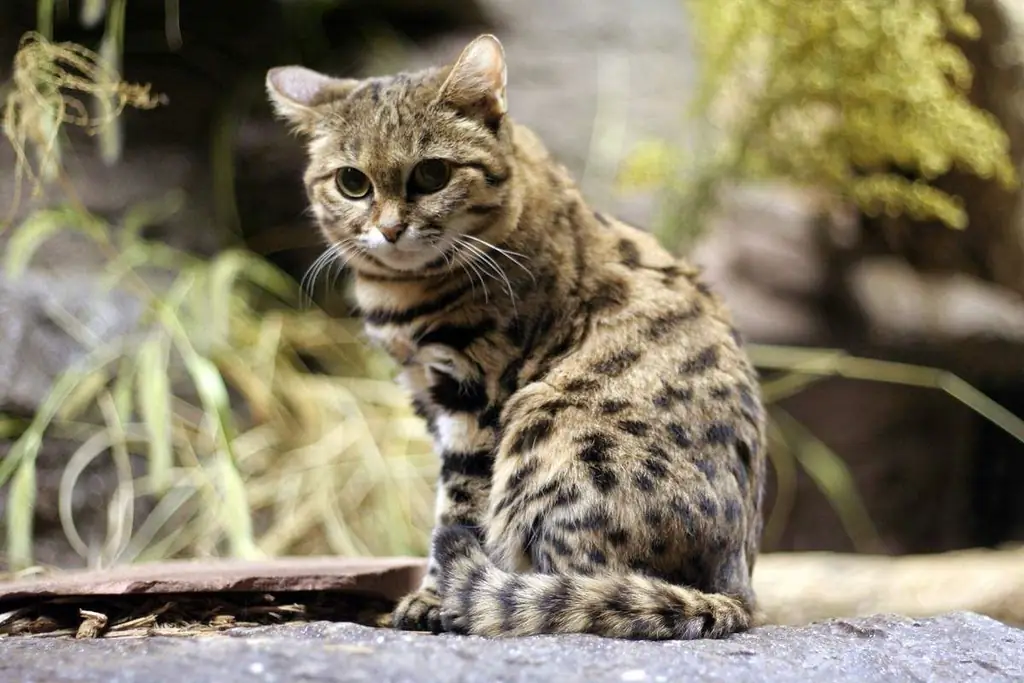
Table of contents:
- Author Bailey Albertson [email protected].
- Public 2023-12-17 12:53.
- Last modified 2025-01-23 12:41.
The little robber - black-footed cat
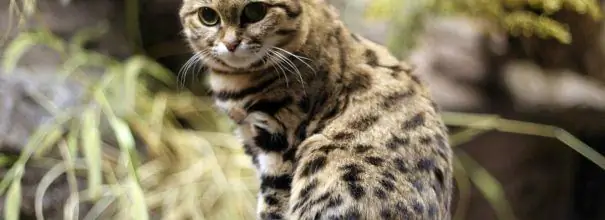
One of the most mysterious and cruel predators of the feline family lives in southern Africa, has a very good-looking appearance and does not exceed the size of an ordinary domestic pussy. We are talking about the black-footed cat - a rare, secretive and gradually disappearing species.
Content
- 1 Distinctive features of the black-footed cat
-
2 Black-footed cat in the wild
- 2.1 Habitats
-
2.2 Lifestyle
2.2.1 Video: Black-footed cat in natural habitat
-
2.3 Reproduction and care of offspring
1 Video: black-footed kitten for a walk
-
3 Life in captivity
-
3.1 Character and behavior
3.1.1 Video: African cat at the zoo
- 3.2 Conditions of detention
- 3.3 Nutrition
- 3.4 Breeding and domestication
-
Distinctive features of the black-footed cat
The African black-footed cat (Felis nigripes) is rightfully considered the smallest wild representative of its family. Adults weigh up to one and a half kilograms, and their body length does not exceed half a meter.
The camouflage color of the wild African cat perfectly disguises the predator against the background of sands and sparse vegetation. The fur coat of this cat is painted in sand color, painted with dark spots and stripes. The shiny coat is coarse and short. On the paws, the stripes form rings; the bottom of the cat's legs are completely black, hence its name. Tufts of dense wool protect the paw pads from the hot sands.
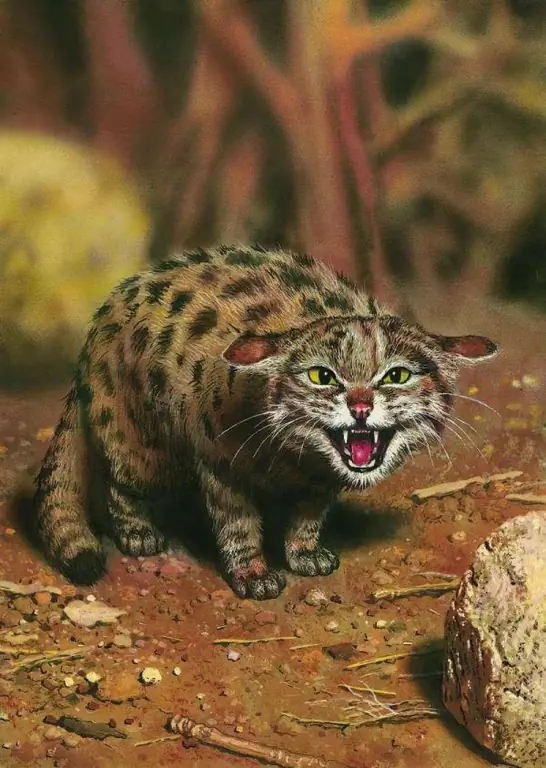
Black bracelets and "slippers" on the paws determined the name of this cat
The animal's body is strong and stocky, the round head is crowned with small, very sensitive ears; greenish eyes are large, unusually expressive, although they look unkind.
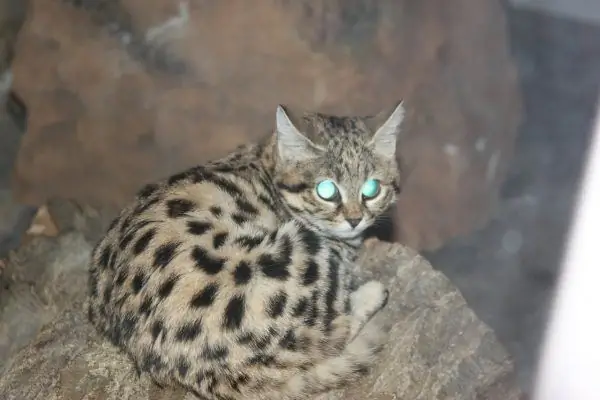
In the dark, the eyes of a wild cat shine with an infernal blue light
Black-footed cat in the wild
The behavior of a wild African cat in vivo remains largely a mystery to researchers. This is a small but bright representative of the amazing fauna of the hottest continent.
Habitat
The black-footed cat lives compactly in the very south of South Africa in desert and semi-desert regions. She also settles in the mountains, but usually does not rise above two thousand meters above sea level. The animal is found on the territory of four bordering countries: Angola, Botswana, Zimbabwe and Namibia.
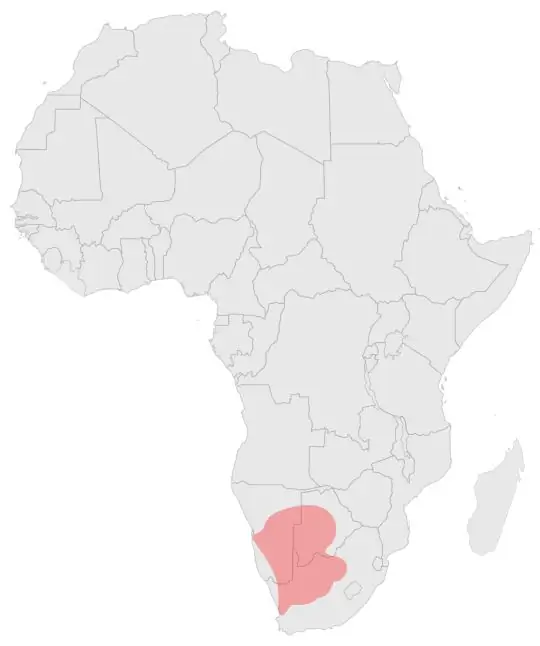
The black-footed cat lives compactly in southern Africa
In most areas, the wild cat is protected by national legislation, hunting it is prohibited, as well as unofficial export outside the continent. The black-footed cat is listed in the CITES Convention and the International Red Book. However, the rules and prohibitions are still violated quite often.
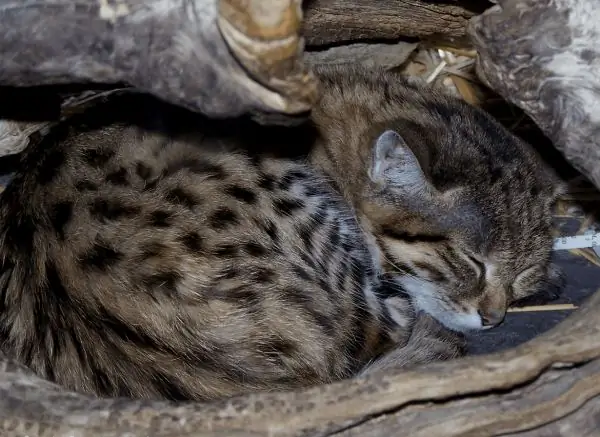
A wild cat prefers not to meet a man - his main enemy
The habitat of the black-footed cat remains unchanged, but the number of its livestock is constantly decreasing. Human economic activity has a negative effect on the population of the species. Many animals die from poisoning with poisons used in agriculture, wild cats often fall into traps set up by humans for other types of predators.
Lifestyle
Outwardly, the black-footed cat is very similar to a cute domestic purr, but the first impression in this case is wrong. The adorable animal is actually a cruel and very active predator, which does not complex at all about its small size, is distinguished by ferocity and rare fearlessness. Black-footed cats lead a secretive and solitary life - they hide in shelters during the day, and go hunting at night.
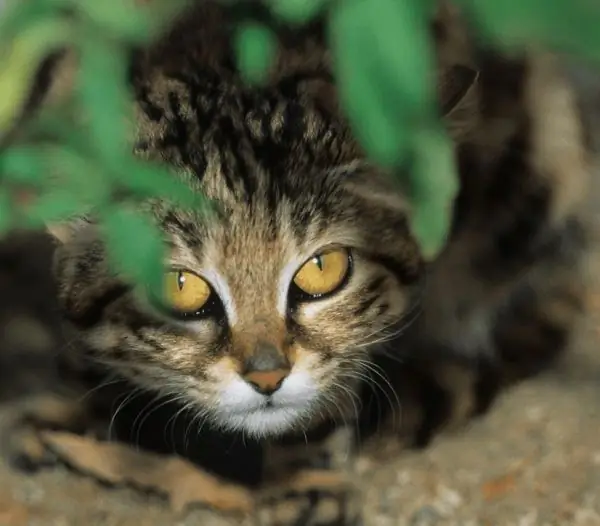
The black-footed cat often hunts from an ambush
The small predator has perfectly adapted to life in hot and arid climates. She, for example, is able to do without water for a long time, getting the necessary liquid from food. This cat is very hardy and tireless. Going out to hunt at dusk, it travels long distances in search of prey and can walk more than ten kilometers per night. In this case, the beast kills significantly more small animals and birds than it can eat. He buries the surplus of the hunted game, marking the places of the hidden supplies.
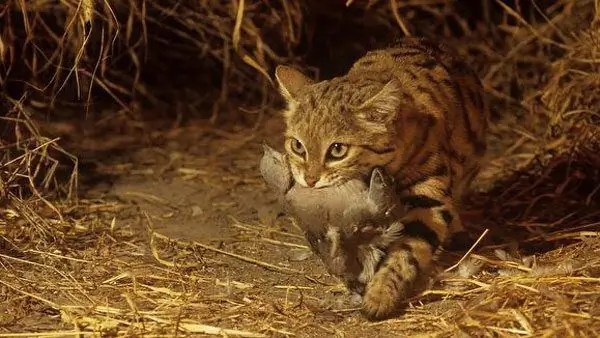
The black-footed cat is the perfect hunter
The diet of a wild African cat is based on various rodents and birds, but sometimes it successfully hunts animals that are several times larger than its size - for example, small antelopes. The black-footed cat's diet includes up to sixty species of a wide variety of animals. This predator can eat reptiles, insects, and carrion, but most of all, of course, it loves fresh meat.

Even large predators try not to get involved with this outrageous
Both snakes and large predators can become natural enemies of the wild African cat. Although the latter, knowing the desperate and courageous disposition of the black-footed cat, usually prefer not to get involved with her - except that they decide to attack the cubs that have been left without a mother for a short time.
Video: black-footed cat in natural habitat
Reproduction and care of offspring
When females come into a state of hunting, they mark the territory and thereby give a sign to the suitors. The parents-to-be pair up for a short time. Their love games do not last long, no more than two or three days, and then the male leaves his girlfriend, giving her all the joys of caring for the offspring.
Soon after mating, the cat begins to look for places for a den - most often it equips rabbit holes for this. A feature of this predator is that it always has several reserve options for the nest. Every few days, she moves the cubs to a new burrow, obviously changing the place of the den for safety reasons.
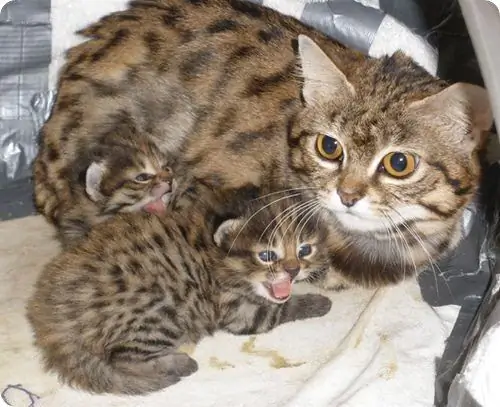
All worries about the offspring fall on the mother cat
Like all small wild cats, young of this species mature very quickly. Already from the age of three weeks, kittens, suspecting danger, leave the den and hide, disguising themselves outside of it. By the age of five months, babies grow to maternal size and begin to hunt on their own. Soon after, they begin to live independently. But these animals are fully formed and become sexually mature only after a year.
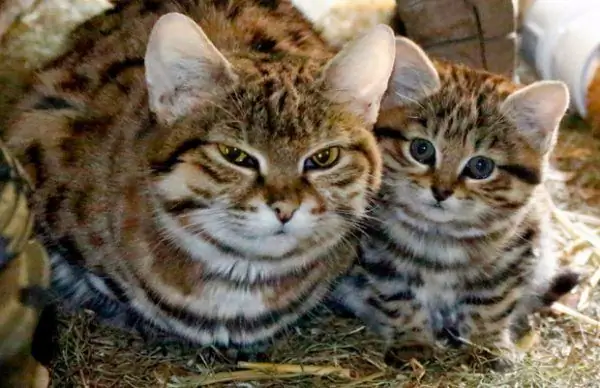
Kittens of this species grow up very quickly.
Video: black-footed cat kitten for a walk
Life in captivity
Despite their unsociable and harsh disposition, black-footed cats easily adapt to being kept in captivity. Although in the zoos of the world there are not so many of these rare animals - no more than five dozen adults. If under natural conditions the life expectancy of an African cat does not exceed thirteen years, then in well-fed and calm conditions of captivity, it lives longer - up to sixteen years.
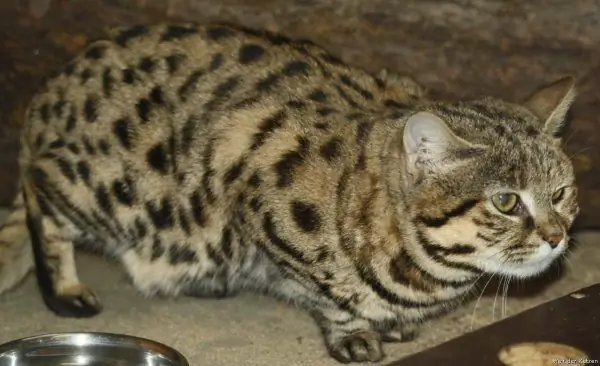
Wild African cat adapts well to captivity
Character and behavior
As well as in natural habitat, in captivity these animals are nocturnal, and in the daytime they sleep off, trying once again not to be seen by people. Perhaps that is why many zoos are not too eager to replenish their collections with representatives of this rare and expensive species - the cost of one individual starts at ten thousand dollars. And visitors may never notice a small black-footed cat emerging from its hiding place only at dusk.
Video: African cat at the zoo
Conditions of detention
It is very important that the wild African cat has a spacious enclosure with a wide variety of hiding places. Even in a zoo, each of the animals should be able to live in their own, albeit small, territory. And for the period of raising the offspring, it is better to move the female with the babies to a separate aviary and isolate from the attention of visitors.
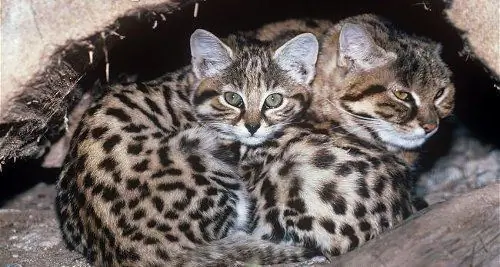
While the children are growing, the cat should not be bothered by anything.
Food
The menu of a black-footed cat in captivity should be as close as possible to its natural diet. But since neither zoos nor private owners can provide their pets in full with such an exotic range of food, various useful additives are used for their nutrition, which in nature these animals do not eat. That is, in a full-fledged menu, in addition to meat and poultry, sea fish, dairy products, eggs and vegetables should be present, which serve as a source of plant fibers necessary for a cat.
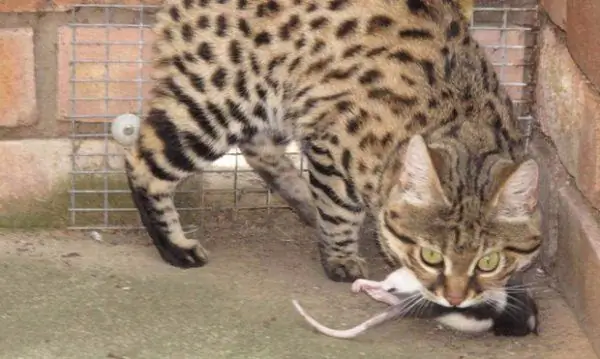
Live food must be on the wild cat's menu
The appetite of a black-footed cat is very good - per day it eats an amount of food equal to half of its own weight. And all this is digested very quickly - the metabolism of the little predator is excellent. But overfeeding the animal is not worth it, in addition, you need to think in a timely manner about how to provide him with sufficient physical activity.
Reproduction and taming
It is futile to hope that it will be possible to make this cute pussy handmade - the genetics of a wild beast is too strong in it. Even kittens born in captivity and fed by a man do not go to rapprochement with a man and from three months they begin to show their wayward character to the maximum. It is impossible to overcome their alertness and suspicion towards people - animals respond with aggression to any attempt to encroach on their independence.
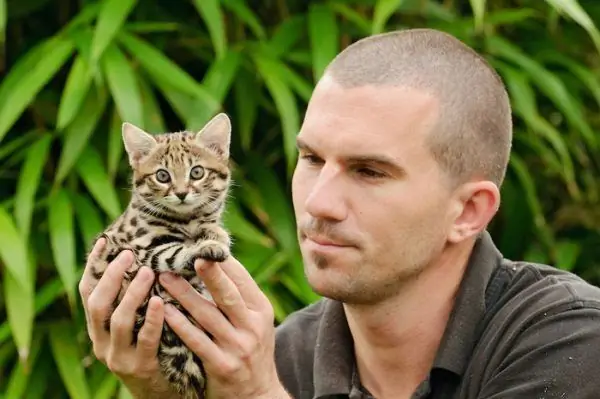
Unfortunately, it's impossible to tame this cute kitten
Much easier to tame mestizos - the fruits of crossing a wild animal with domestic cats; such experiments are often successful.
The fashion for keeping wild exotic animals has done a disservice to the black-footed cat - a small predator, which already has many problems because of man. It should be remembered: this beast is definitely not for housing maintenance - it is impossible to completely tame it, you should not even try.
Recommended:
Pallas' Cat: Lifestyle Of A Cat, Habitat, Keeping In Captivity, Photo, Is It Possible To Tame A Wild Kitten
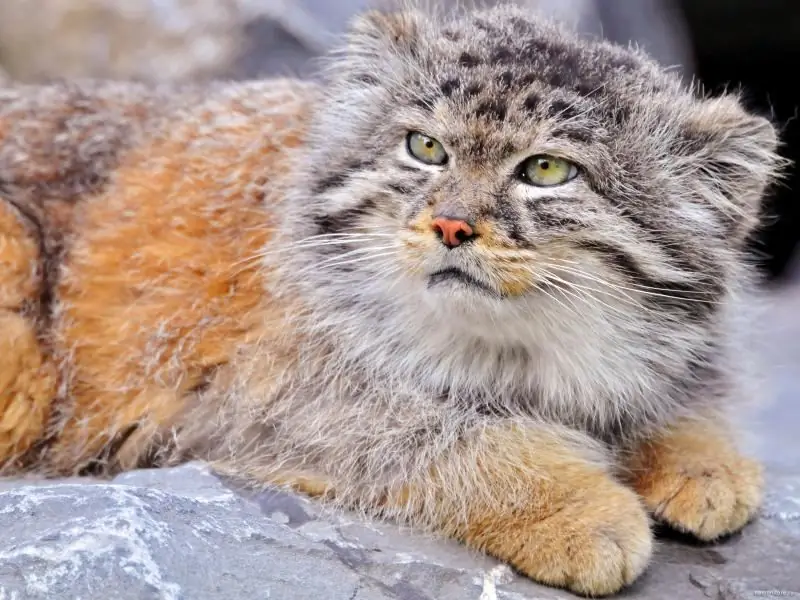
Wild cat manul: a description of the appearance of the animal, its life, character and behavior of the manul in the wild and when kept in captivity. Power features
Steppe Cat: Lifestyle, Habitat, Keeping In Captivity, Breeding And Feeding Of The Cat

The appearance of a steppe cat. Habitat. Life in the wild. What do spotted cats eat? Reproduction and life expectancy. Wild cats in captivity
Andean Cat: Description Of The Breed, Nature And Habits, Habitat, Keeping In Captivity, Photo
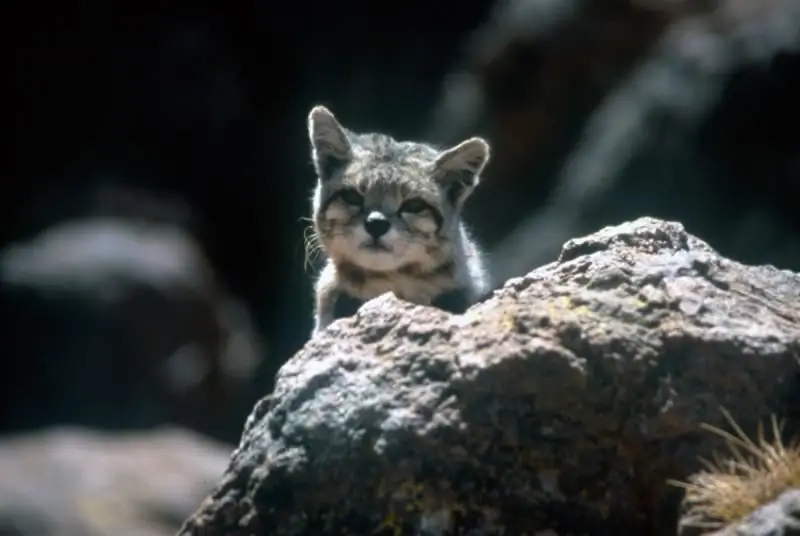
How this rare cat was discovered. What does an Andean cat look like, where it lives in nature, what kind of life it leads, can it be kept in captivity
Far Eastern Forest Cat (Amur): What It Looks Like, Photo, Habitat, Keeping In Captivity
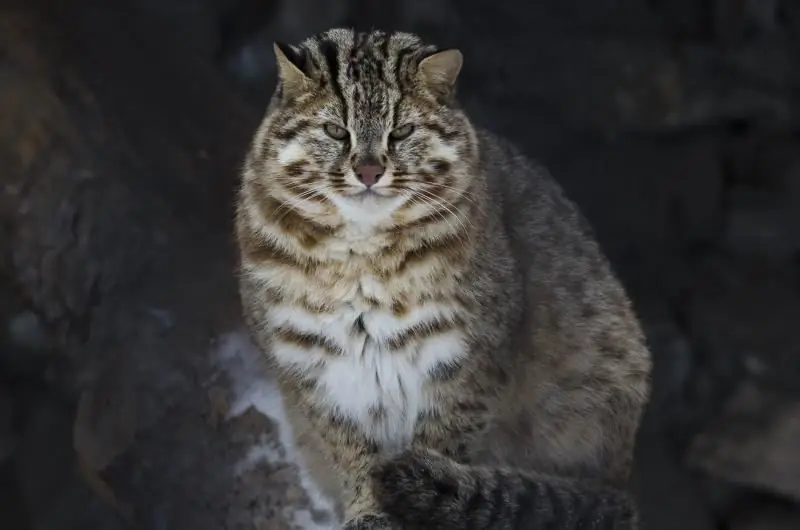
The appearance of the Amur wild cat. Range and lifestyle of the Far Eastern forest cat. The life of an Amur cat in captivity. Conditions of detention and safety
Chinese Cat: Breed Standards, Character And Habits, Health And Nutrition, Photos, Habitats, Keeping In Captivity

History of the Chinese (mountain) cat. What a gobi cat looks like. Where does the Chinese cat live and what it eats. Reproduction issues. Maintenance and care in captivity
